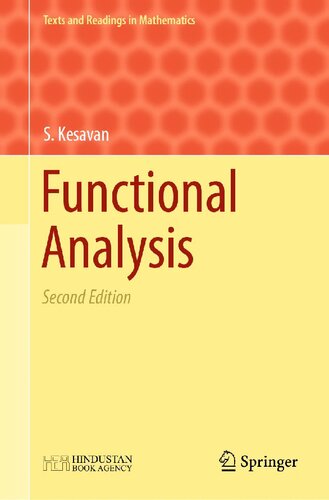
Functional Analysis PDF
Preview Functional Analysis
Texts and Readings in Mathematics AdvisoryEditor C.S.Seshadri,ChennaiMathematicalInstitute,Chennai,India ManagingEditor RajendraBhatia,AshokaUniversity,Sonepat,Haryana,India EditorialBoard ManindraAgrawal,IndianInstituteofTechnology,Kanpur,India V.Balaji,ChennaiMathematicalInstitute,Chennai,India R.B.Bapat,IndianStatisticalInstitute,NewDelhi,India V.S.Borkar,IndianInstituteofTechnology,Mumbai,India ApoorvaKhare,IndianInstituteofScience,Bangalore,India T.R.Ramadas,ChennaiMathematicalInstitute,Chennai,India V.Srinivas,TataInstituteofFundamentalResearch,Mumbai,India TechnicalEditor P.Vanchinathan,VelloreInstituteofTechnology,Chennai,India TheTextsandReadingsinMathematicsseriespublisheshigh-qualitytextbooks, research-level monographs, lecture notes and contributed volumes. Undergraduate and graduate students of mathematics, research scholars and teachers would find this book series useful. The volumes are carefully written as teaching aids and highlightcharacteristicfeaturesofthetheory.Booksinthisseriesareco-published withHindustanBookAgency,NewDelhi,India. S. Kesavan Functional Analysis Second Edition S.Kesavan Emeritus,TheInstituteofMathematical Sciences Chennai,India ISSN 2366-8717 ISSN 2366-8725 (electronic) TextsandReadingsinMathematics ISBN ISBN 978-981-19-7633-9 (eBook) https://doi.org/10.1007/978-981-19-7633-9 Thisworkisaco-publicationwithHindustanBookAgency,NewDelhi,licensedforsaleinallcountries inelectronicformonly.SoldanddistributedinprintacrosstheworldbyHindustanBookAgency,P-19 GreenParkExtension,NewDelhi110016,India. JointlypublishedwithHindustanBookAgency ISBNoftheHindustanBookAgencyedition:978-819-51-9613-5 MathematicsSubjectClassification:46-01 2ndedition:©HindustanBookAgency2023 Thisworkissubjecttocopyright.AllrightsaresolelyandexclusivelylicensedbythePublisher,whether thewholeorpartofthematerialisconcerned,specificallytherightsoftranslation,reprinting,reuse ofillustrations,recitation,broadcasting,reproductiononmicrofilmsorinanyotherphysicalway,and transmissionorinformationstorageandretrieval,electronicadaptation,computersoftware,orbysimilar ordissimilarmethodologynowknownorhereafterdeveloped. Theuseofgeneraldescriptivenames,registerednames,trademarks,servicemarks,etc.inthispublication doesnotimply,evenintheabsenceofaspecificstatement,thatsuchnamesareexemptfromtherelevant protectivelawsandregulationsandthereforefreeforgeneraluse. Thepublishers,theauthors,andtheeditorsaresafetoassumethattheadviceandinformationinthisbook arebelievedtobetrueandaccurateatthedateofpublication.Neitherthepublishersnortheauthorsor theeditorsgiveawarranty,expressedorimplied,withrespecttothematerialcontainedhereinorforany errorsoromissionsthatmayhavebeenmade.Thepublishersremainneutralwithregardtojurisdictional claimsinpublishedmapsandinstitutionalaffiliations. ThisSpringerimprintispublishedbytheregisteredcompanySpringerNatureSingaporePteLtd. The registered company address is: 152 Beach Road, #21-01/04 Gateway East, Singapore 189721, Singapore Preface Functional analysis studies linear spaces provided with suitable topological struc- turesand(continuous)lineartransformationsbetweensuchspaces.Ithasfarreaching applicationsinseveraldisciplines.Forinstance,themoderntheoryof(partial)differ- ential equations and the numerical approximation of their solutions rely a lot on functionalanalytictechniques. Functionalanalysisisnowanintegralpartofthecurriculuminanypostgraduate courseinMathematics.Ideallyitshouldbetaughtafterhavingcovered courses in linearalgebra,realandcomplexanalysis,andtopology.Anintroductiontothetheory of measure and integration is also helpful since the richest examples in functional analysiscomefromfunctionspaceswhosestudydemandssuchaknowledge. Thepresentbookgrewoutofnotespreparedbymyselfwhilelecturingtograduate studentsattheTataInstituteofFundamentalResearch(BangaloreCentre)andthe InstituteofMathematicalSciences,Chennai.Thematerialpresentedinthisbookis standardandisideallysuitedforacoursewhichcanbefollowedbymastersstudents who have covered the necessary prerequisites mentioned earlier. While covering all the standard material, I have also tried to illustrate the use of various theorems viaexamplestakenfromdifferentialequationsandthecalculusofvariations,either throughbriefsectionsorthroughtheexercises.Infact,thisbookiswellsuitedfor students who would like to pursue a research career in the applications of mathe- matics.Inparticular,familiaritywiththematerialpresentedinthisbookwillfacilitate studyingmyearlierbook,publishednearlytwodecadesago,‘TopicsinFunctional Analysis and Applications’ (Wiley Eastern, now called New Age International), whichservesasafunctionalanalyticintroductiontothetheoryofpartialdifferential equations. Chapter1givesarapidrevisionoflinearalgebra,topologyandmeasuretheory. Importantdefinitions,examplesandresultsarerecalledandnoproofsaregiven.At theendofeachsection,thereaderisreferredtoastandardtextonthattopic.This chapterhasbeenincludedonlyforreferencepurposesanditisnotintendedthatit becoveredinacoursebasedonthisbook. Chapter2introducesthenotionofanormedlinearspaceandthatofcontinuous lineartransformationsbetweensuchspaces. v vi Preface Chapter3studiestheanalyticandgeometricversionsoftheHahn-Banachtheorem andpresentssomeapplicationsofthese. Chapter4isdevotedtothefamous‘trinity’infunctionalanalysis—theBanach- Steinhaus, the open mapping and the closed graph theorems, which are all conse- quences of Baire’s theorem for complete metric spaces. Several applications are discussed.Thenotionofan‘unboundedlinearmapping’isintroduced. Inmyopinion,mosttextsdonotemphasizetheimportanceofweaktopologiesin acourseonfunctionalanalysis.Thataboundedsequenceinareflexivespaceadmits aweaklyconvergentsequenceisthecornerstoneofmanyanexistenceproofinthe theoryof(partial)differentialequations.Thesetopologiesalsoprovidenicecounter- examplestoshowtheinadequacyofsequencesinageneraltopologicalspace.For instance,wewillseethattwotopologiesonasetcouldbedifferentwhilehavingthe sameconvergentsequences.Wewillalsoseeanexampleofacompacttopological spaceinwhichasequencedoesnothaveanyconvergentsubsequence.Chapter5deals withweakandweak*topologiesandtheirapplicationstothenotionsofreflexivity, separabilityanduniformconvexity. Chapter6introducestheLebesguespacesandalsopresentsthetheoryofoneof thesimplestclassesofSobolevspaces.Chapter7isdevotedtothestudyofHilbert spaces.Chapter8studiescompactoperatorsandtheirspectra. Much of the fun in learning mathematics comes from actually doing it! Every chapter from Chapters 2 through 8 has a fairly large collection of exercises at the end.Theseillustratetheresultsofthetext,showtheoptimalityofthehypothesesof the various theorems via various examples or counterexamples, or develop simple versionsoftheoriesnotelaborateduponinthetext.Theyareofvaryingdegreesof difficulty.Occasionally,somehintsforthesolutionareprovided.Itishopedthatthe studentswillbenefitbysolvingthem. Since this is meant to be a first course on functional analysis, I have kept the bibliographic references to a minimum, merely citing important texts where the readermayfindfurtherdetailsofthetopicscoveredinthisbook. No claim of originality is made with respect to the material presented in this book. My treatment of this subject has been influenced by the writings of authors like Simmons (whose book was my first introduction to Functional Analysis) and Rudin. These works figure in the bibliography of this book. I would also like to mention a charming book, hardly known outside the francophonic mathematical community,viz.‘AnalyseFonctionnelle’byH.Brézis. The preparation of this manuscript would not have been possible but for the excellentfacilitiesprovidedbytheInstituteofMathematicalSciences,Chennai,and I wish to place on record my gratitude. I also thank the Hindustan Book Agency and the editor of the TRIM Series, Prof. R. Bhatia, for their kind cooperation in bringing out this volume. I must thank the anonymous referees who painstakingly went through the first draft of the manuscript. I have tried to incorporate many of theirconstructivesuggestionsinthecurrentversion. Preface vii Finally,Ithankmyfamilyforitsconstantsupportandencouragement. Chennai,India S.Kesavan May2008 Preface to the Second Edition ItisnowmorethanadecadesincethefirsteditionofthisbookappearedandIam gratified by the reception accorded to it by mathematics students and teachers in thiscountryandalsoinmanyplacesabroad.Thebookhasbeenusedasatextfor FunctionalAnalysiscoursesinmanyinstitutionsandalsoasthemainreferencetext forseveralrefreshercoursesonthissubject. ImyselfhaveusedittoteachacourseonFunctionalAnalysisininstitutionslike the Chennai Mathematical Institute (CMI) and the Indian Institute of Technology Madras (IITM). I have also used it to deliver a course on this subject under the NPTELbanner.Whilegivingtheselectures,Ihavefacedquestionsfromstudents, preparedexercisesforweeklyassignmentsandexaminationsandhavealsoimproved myownappreciationofthefinerpointsofthesubject.Thesefactorsencouragedme to prepare this revised version of the book, and I hope it will be more useful and user-friendlythanthefirstedition. In the present (second) edition, I have completely overhauled the presentation withoutchangingthebasicstructureofthebook.Thestatementsofresults,definitions and remarks have been modified wherever necessary, and many proofs have been rewritten, in view of greater clarity of the exposition. Some examples have been addedtoillustratetheresultsprovedinthetext.Severalexerciseshavebeenaddedto theexistingcollectionineachchapter.Itishopedthatstudentswillhavefunsolving them. Section 3.1, which originally dealt with the Hahn-Banach theorem and intro- duced the notion of reflexivity, has now been bifurcated into two sections. In the newframework,Sect.3.1dealswiththeHahn-Banachtheorem(extensionversion) anditsimmediateconsequences.Section3.2isdevotedtoreflexivity.Severalexam- ples of continuous linear functionals, which do not realize their norm on the unit sphere,arepresented,therebyprovingthenon-reflexivityofmanyfamiliarBanach spaces.Similarly,Sect.8.3,whichoriginallyintroducedthenotionofthespectrum of an operator and described that of a compact operator, has been bifurcated into two sections. Section 8.3 introduces the notion of the spectrum. Several examples are presented, and the spectra of some special operators on a Hilbert space are characterized.Section8.4dealswiththespectrumofacompactoperator. ix x PrefacetotheSecondEdition The final preparation of the manuscript was done while I was working from home,partlyduetotheCOVID-19pandemic,andthiswaspossiblebecauseofthe help rendered by the system administration team of the Institute of Mathematical Sciences(IMSc).Inparticular,IthankMr.G.S.Vasanforhishelp.Ialsothankmy colleaguesProfs.AmritanshuPrasadandS.Viswanathforintroducingmetothejoys ofteachingontheNPTELplatform.IusethisopportunitytothanktheNPTELteam atIITMadras,headedbyMs.BharathiandablyassistedbyMs.LakshmiPriya,for theirsupportandhelpwhenpreparingmyNPTELcourses.Finally,IthankShriJ. K.JainoftheHindustanBookAgencyandProf.RajendraBhatia,thechiefeditor oftheTRIMSeries,forencouragingmetobringoutthisnewedition. Chennai,India S.Kesavan April2022
